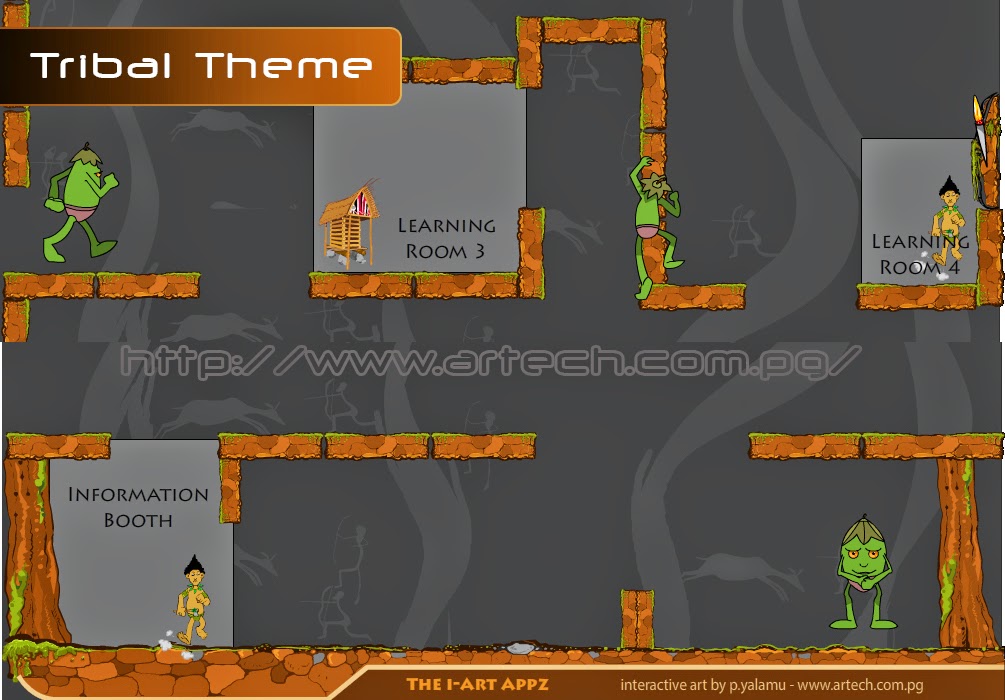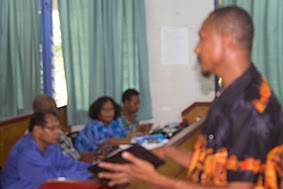The idea of developing Custom-Fonts came about in mid-2006, after going through several of the publication designs (posters, brochures, prints, signs & billboards, etc..) done within PNG and seeing that we are not culturally represented in some of the publications. Because culture is an integral part of Papua New Guinean societies, I feel there is greater need to promote it more using provided technology. This challenged me to research further on some ways to incorporate our cultural themes with technology and share it to the world.
I came up with some fonts for my collections in 2006 but then thought it would be more wiser to include the younger generation (my students at uni) in this project. So in 2007, this thought paved way for more collective cultural motifs from younger typograpers which resulted in the development of version 1.0 of Kumul Fonts.
Kumul Fonts Version 1.0 is specifically dedicated to raising funds for more innovative projects. The individual fonts each carry the designer's names and theme. All of the fonts are branded KF, short for Kumul Fonts.
Culturally, Papua New Guinea is so diverse in terms of it's cultures and languages. So complex in many ways culturally and geographically. As of the writing of this post, we have not really developed our own typefaces or even thought of creating something that other people would use particularly in art during this time of technological intervention. I've realised this and thought it'd be more interesting if we start working on this font collections. In a way, this creation can open our eyes to look beyond just using someone else's creation and start creating something that other people can use. This can be a positive direction that will contribute to the design industry of our country.
From a personal direction, Kumul Font development is part of the drive to utilise my abilities in visual arts and computing, making use of the few years of prior trialing. It put together different knowledge in illustrations, graphic design, multimedia, software programming, project management and leadership.
DEVELOPMENT PROCESS:
Before the designs are sketched and illustrated, a subject is selected. In this case, the subject is the common cultural figure/ identity or traditional design likely to be found in the designer’s home ground. Again, for someone from the Popondetta area in the Oro Province, the designer would most likely select the Tapa design as the subject to base the types around. We tried to make it more generalised so that each theme captures and promotes the different regions.
From the subject, characters are developed to imitate letters A – Z (upper case) and a – z (lower case), numbers 0 – 9 and common symbols such as ? ! “ : ; ‘ / , . & ) ( _ \ etc…
These characters are custom to the keyboard on the computer and they are the characters which would be brought up when the user type the keys responding to each character.
The illustrations are traced with inks (usually calligraphic pen), the characters scanned and digitized, cleaned, traced and converted into readable font formats (True Type Fonts). Once all these has been done, the fonts are compiled using one of the programming languages and all contents packaged (put together) ready for distribution.
RECOGNITION:
This initiative (former-Fantasy Fonts) was nominated as the best e-Culture project of the Pacific by panel experts in New Zealand for the World Summit Awards in Britain in 2008.
COMPATIBILITY:
The current version [Kumul Fonts V1.0] is packaged for distribution on windows computers. In the future, we would create versions compatible for macintosh.
Once the fonts are installed, they are standardized and will work on any application that enables the use of fonts. The fonts have been tested on all Office applications (Word, Access, Excel, PowerPoint, Publisher), Adobe applications (Illustrator, InDesign, Photoshop,ImageReady,) and most other applications that uses texts. I will still upgrade the version with new features and new font designs would also be added as well in the future.
CREDITS:Digital enhancements, Fonts Conversion and Software programming is done by Me, myself and I (smiles)..
The illustrations of fonts are done by Final year Arts & Design students of the University of PNG in 2007, 2008,2009,2010 and 2011.
PUBLICATIONS:
Sunday Chronicle FEATURE Sunday January 27 2008
National Newspaper WEEKENDER December, 2007
In Moresby Tonight FEATURED ARTIST December, 2007 8:30 pm
Radio Australia THE LOOP Tuesday October 28 2008 1:30 pm
I came up with some fonts for my collections in 2006 but then thought it would be more wiser to include the younger generation (my students at uni) in this project. So in 2007, this thought paved way for more collective cultural motifs from younger typograpers which resulted in the development of version 1.0 of Kumul Fonts.
Kumul Fonts Version 1.0 is specifically dedicated to raising funds for more innovative projects. The individual fonts each carry the designer's names and theme. All of the fonts are branded KF, short for Kumul Fonts.
Culturally, Papua New Guinea is so diverse in terms of it's cultures and languages. So complex in many ways culturally and geographically. As of the writing of this post, we have not really developed our own typefaces or even thought of creating something that other people would use particularly in art during this time of technological intervention. I've realised this and thought it'd be more interesting if we start working on this font collections. In a way, this creation can open our eyes to look beyond just using someone else's creation and start creating something that other people can use. This can be a positive direction that will contribute to the design industry of our country.
From a personal direction, Kumul Font development is part of the drive to utilise my abilities in visual arts and computing, making use of the few years of prior trialing. It put together different knowledge in illustrations, graphic design, multimedia, software programming, project management and leadership.
DEVELOPMENT PROCESS:
Before the designs are sketched and illustrated, a subject is selected. In this case, the subject is the common cultural figure/ identity or traditional design likely to be found in the designer’s home ground. Again, for someone from the Popondetta area in the Oro Province, the designer would most likely select the Tapa design as the subject to base the types around. We tried to make it more generalised so that each theme captures and promotes the different regions.
From the subject, characters are developed to imitate letters A – Z (upper case) and a – z (lower case), numbers 0 – 9 and common symbols such as ? ! “ : ; ‘ / , . & ) ( _ \ etc…
These characters are custom to the keyboard on the computer and they are the characters which would be brought up when the user type the keys responding to each character.
The illustrations are traced with inks (usually calligraphic pen), the characters scanned and digitized, cleaned, traced and converted into readable font formats (True Type Fonts). Once all these has been done, the fonts are compiled using one of the programming languages and all contents packaged (put together) ready for distribution.
RECOGNITION:
This initiative (former-Fantasy Fonts) was nominated as the best e-Culture project of the Pacific by panel experts in New Zealand for the World Summit Awards in Britain in 2008.
COMPATIBILITY:
The current version [Kumul Fonts V1.0] is packaged for distribution on windows computers. In the future, we would create versions compatible for macintosh.
Once the fonts are installed, they are standardized and will work on any application that enables the use of fonts. The fonts have been tested on all Office applications (Word, Access, Excel, PowerPoint, Publisher), Adobe applications (Illustrator, InDesign, Photoshop,ImageReady,) and most other applications that uses texts. I will still upgrade the version with new features and new font designs would also be added as well in the future.
CREDITS:Digital enhancements, Fonts Conversion and Software programming is done by Me, myself and I (smiles)..
The illustrations of fonts are done by Final year Arts & Design students of the University of PNG in 2007, 2008,2009,2010 and 2011.
PUBLICATIONS:
Sunday Chronicle FEATURE Sunday January 27 2008
National Newspaper WEEKENDER December, 2007
In Moresby Tonight FEATURED ARTIST December, 2007 8:30 pm
Radio Australia THE LOOP Tuesday October 28 2008 1:30 pm



































